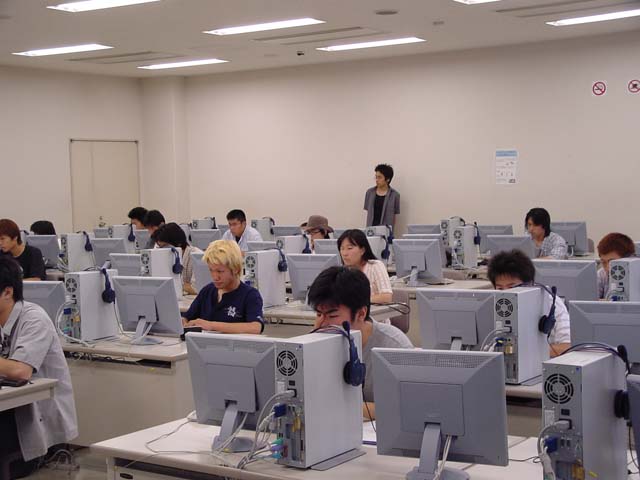The English Language Education Program (10 required credits) in the College of Information Science and Engineering (CISE), which began in 2004, the year of its establishment, and has been in practice for eight academic years through 2011, is based on the results of an English placement test developed independently during the orientation period at the beginning of April, with the full support of the Language Center. Students were divided into 5-7 classes at 5 levels: Advanced, Upper Intermediate, Intermediate, Lower Intermediate, and Lower Intermediate, and “Listening and Speaking”, “Reading & Writing”, and “CALL” classes were offered three times a week for 90 minutes each class. As much as possible, full-time and part-time native English-speaking teachers and Japanese English teachers who were deemed appropriate were assigned to the intermediate and higher level classes, while full-time Japanese English teachers were mainly assigned to the lower level classes. Advanced and upper-intermediate level classes used textbooks from Western publishers that matched their level, while lower-intermediate and lower-intermediate classes used textbooks from Japanese publishers as their primary textbooks. The TOEIC (Test of English for International Communication), which was used throughout the university, was administered in early December of each year, and levels and classes were set to reflect the results of individual students, moving them up or down. I was in charge of the advanced and upper-intermediate “CALL” classes and “Reading & Writing” classes, which were basically taught in English only, without using Japanese, to provide a practitioner model of “English as an international language” and to give students the confidence that they can communicate in basic English even at their own level of English proficiency. I hoped that students would gain confidence in their ability to communicate in English even at their own level of English proficiency.
新設年度である2004年度から開始され、2011年度までの8年間実践した情報理工学部の英語教育プログラム(必修10単位)は、4月初めのオリエンテーション期間中に独自に開発した英語プレイスメントテストを言語センターの全面的なサポートのもと実施し、その結果によって「上級クラス/Advanced」、「中上級クラス/Upper Intermediate」、「中級クラス/Intermediate」、「下中級クラス/Lower Intermediate」、「下級クラス/Lower」の5レベルの5~7クラスに分けられ、「リスニング&スピーキング」、「リーデイング&ライテイング」、「CALL」の科目として各クラス90分で週3回行われた。中級以上のクラスの担当者には、できる限り常勤・非常勤の英語母語話者教員や適任と思われた日本人英語教員に担当してもらい、下級クラスは専任の日本人英語教員が主に担当した。上級及び中上級レベルのクラスではレベルに合致した洋書出版社のテキストを使用し、下中級及び下級クラスでは、日本の出版社のテキストを主たるものとして使用した。全学で採用されているTOEIC (Test of English for International Communication)を毎年12月初旬に実施し、個々学生の結果を反映してレベルとクラス設定をして、上下移動をさせた。私が担当したクラスは上級と中上級の「CALL」クラスと「リーデイング&ライテイング」クラスで、基本的に日本語を使わず、英語のみで授業を運営するスタイルで、「国際語としての英語」の実践者モデルを提供して、履修者である学生たちにも自己のレベルの英語力でも基本的な英語コミュニケーションができるという自信を持ってもらうようにとの願いを込めたものだった。

Since the 2012 academic year, I have been involved in the start-up English Language Program for the new department and have taken a leadership role in the English education program. The full-time English faculty hired to replace me has been entrusted with the task of building and managing the new curriculum. The “CALL” class was eliminated as the curriculum was changed to a more general academic skills curriculum due to the increase in digitally native students. I must be based on the “spirit of reform” (?) trend of Ritsumeikan University, one of the leading private universities in western Japan. Until I retired at the end of the 2017 academic year, I was in charge of teaching intermediate and advanced-level English classes and Nonverbal Communication in English (one of the international liberal arts courses that were open to the entire university and offered to students from a variety of faculties as a sampling compulsory subject). Until the end of FY2021, the classes I taught as a specially appointed professor were changed to lower-level English classes. Some classes were then given project-based learning to create a promotional video “introducing Japanese culture in English” using iPads (up to 20 iPads were used for the purpose) purchased with the research and experimental training budgets, and small groups of randomly selected students were asked to create the videos and give presentations in the classroom using them. The students were also asked to make online video presentations using the Flip site as individual projects and to evaluate each other (Peer-to-Peer Evaluation) using Google Forms. The results of the post-program questionnaires indicated that the students were satisfied with the fun learning experience.
2012年度からは、学部新設におけるスタートアップ・英語教育プログラムに関与し、リーダーシップを取ってきたが、後任人事で採用された専任英語教員に新規カリキュラムの構築と運営方法を一任した。デジタル・ネイテイブ学生たちの増加から、従来より一般的なアカデミック・スキルの学習目的のカリキュラムに変更されたため、「CALL」クラスは廃止された。西日本を代表する私立大学の1つである立命館大学の「改革魂(?)」トレンドと言うべきか、学部ごとに4年ごとに小規模のカリキュラム改革、8年ごとに大規模なカリキュラム改革を実施するのが伝統的なスタイルとなっていたので、自然の流れと言える。2017年度終了と共に定年退職するまで、私の担当する科目は中上級レベルの英語科目と全学にオープンされ多様な学部から履修生たちが学べる国際教養科目の1つ「非言語コミュニケーション」であったが、2021年度終了までの特別任用教授としての担当英語科目は下級レベルの英語クラスに変更され、やや英語力の低い学生たちに英語学習の重要性を説き、英語オンリーでの授業運営方法は変えず、研究費・実験実習費などの予算を活用して購入したiPad(最大20台まで購入)を使って、「日本文化を英語で紹介する」プロモーショナル・ビデオ作成プロジェクトを課し、ランダムに人選した小グループで取り込まさせ、それら動画を使った教室でのプレゼンテーションをさせたり、個人ごとに取り組むプロジェクトとしてFlipサイトを利用してオンラインでビデオ・プレゼンテーションとGoogle Formを使った学生同士の評価方法を実施し、「やる気」を持たせ、「達成感」を得らせる工夫をした。事後アンケートの結果から、おおよそ満足できた「楽しい学び」だったようである。

